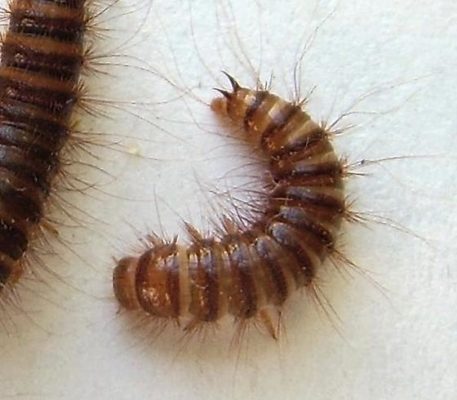Chances are you’ve seen a larder beetle before. If someone described a small, oval bug with a dark-colored body and a light stripe around, it would probably sound familiar. Larder beetles are a common and frequent guest in both residential and commercial settings. The name comes from their presence in dried, cured meats stored at room temperature prior to refrigeration. These days, they are still found in stored foods in pantries, but also damage furs, feathers, and leather. They may also be attracted by carcasses of dead insects in your walls and home. They are even capable of gnawing through lead and tin. No need to fear, though, Modern Pest is here with tips for prevention and treatment options!
If you’ve seen larder beetles or any other pests in your home, click here or call 1-800-323-7378 to schedule service today!
Description
- Adult larder beetles are usually 1/4 to 3/8 inches in length with a long, oval-shaped body.
- Adults are dark brown to black, with a wide, yellow band running across their bodies. The band contains six dark spots.
- Larder beetle larvae are up to 1/2-inch long and are tapered in shape. They are covered with sparse, stiff hair.

Where Did They Come From?
Larder beetle adults overwinter in protected places like cracks and crevices. In the spring, they are attracted to areas with food sources in homes and buildings. Both the larvae and the adult larder beetle cause damage feeding and boring into solid materials in which to pupate.
Diet
Larder beetles can thrive anywhere they find a sustainable food source. They prefer meat or meat by-products such as cheese, dry pet food, feathers, and furs. When an infestation is found in a home, it most likely came from dry dog, cat, or bird food. They also feed on dead animal matter like cluster flies, boxelder bugs, or mice that might be in the walls of homes. Grease resulting from cooking also attracts larder beetles.
Reproduction
Adult females lay their eggs on any one of their many feeding sources, or in cracks or crevices near the food source. In the Summer, they lay as many as 100 eggs, which will hatch in about 12 days. The male larvae molt 5 times while the female molts 6 times. The mature larva will seek a location to bore into and pupate.
New Homecare Green clients can schedule service online by clicking here!
How to Avoid an Infestation
- Be sure to keep all human and pet food products in airtight glass, plastic, or metal containers.
- If you encounter a larder beetle infestation in a pantry or cupboard, look for the source. Remove all food items and discard infested products. Inspect all products before returning to the cleaned shelves.
- Thoroughly vacuum and clean the affected shelves.
- If the specific source of the infestation can’t be pinpointed, employ a general control process and vacuum cracks and crevices in the areas where the beetles were found.
- If valuable materials are infested, they can be heat sterilized at 140 degrees F for 30 minutes, or frozen for three to four days.
The Modern Solution
If you’ve seen larder beetles in your home, they could be ruining your food and boring holes. Give Modern Pest a call today at 1-800-323-7378. Our Homecare Green service protects against over 50 common household pests, including larder beetles. And our Ecocare services also treat for larder beetles in commercial-settings. New customers can now schedule service all online by clicking here!


